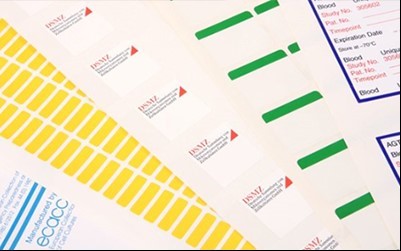6 ways to improve illegible Handwritten Labels
Whether you are labelling decanted chemical/solvent containers for health and safety, calibrating equipment for ISO 9001:2008 (7.6 Control of Monitoring & Measuring Equipment) in an engine manufacturing plant for example or writing clinical trial information on a laboratory vial as part of laboratory best practice, reading other peoples hand writing can be a challenge.

The repetitive nature of hand writing labels often means that the legibility deteriorates as the numbers increase. Also, it isn't necessarily the same person who writes the label that needs to read it.
Add to this the environment where the labels are used and the information can smudge, fade disintegrate or fall off, if the correct label material hasn't been used and is not fit for purpose.
The key is to make sure that you have a correctly specified label and you remove or reduce the amount of hand written data.
Here are 6 alternative ideas.
- Use a computer imprintable laboratory or industrial label specifically designed for the environment. Durable label materials are usually made from polyester and can be printed using a Laser or Thermal Transfer printer. You can also use a dot matrix printer if you still have one but they are for the most part extinct!
- Completely laser print your labels, printing the entire label with a black toner A4 laser printer is a great solution if you don't want to buy a special printer. The label and print durability will resist mild solvents, chemicals, cleaning agents, IPA, fuel, repeated handling and abrasion. You could use blank labels or labels that have been part pre-printed by the label manufacturer.

Drawback and alternatives if you don't have large batches: A sheet of labels should only be printed once. The upper temperature threshold of polyester is usually ~150°C and the laser printing process heats to ~220°C for 23/1000's of a second. This does not effect the performance of the label but it is unwise to print a sheet of labels more than once. Any ambient moisture in the backing sheet will be sucked dry during the first pass thorough the printer, removing the sheet's lay flat properties making a second print pass problematic and the surface coating softens during a second and third pass, retaining surplus toner, making the freshly printed labels look dirty.
Solution: If you can not print an entire A4 sheet in one go, consider using A5 or mini sheets, after all, if your printer can print an envelope, a mini sheet of labels can be manufactured. There is no law that states that durable labels must be produced on A4 sheets!

- Compromise - partially laser print your labels. Why not purchase blank durable computer imprintabe labels and print the majority of the static or variable data in batches and design the label to have hand written areas for the minimum of data, e.g. initials and date etc. Entry level label software will let you create your own labelling solution. Its worth mentioning here that the matt computer imprintable coating on laser imprintable labels can be easily written on with a ball point pen or an indelible fine point pen for increased durability.
- Print labels one at a time. The ideal solution is to print your labels with a thermal transfer printer.
If you have the budget of £300-400 (for an entry level printer) to dedicate to this solution then thermal transfer imprintable labels are the way to go.
You print labels 'on demand' one at a time and the printers can be supplied with label materials and ribbon combinations that will resist everything up to and including Acetone and thinners in an industrial environment, and xylene in a histology laboratory.
- Have the labels printed for you. If the data can be batched and made available in advance, have the labels pre-printed for you and delivered so that all you do is peel and stick. No printing hassle.
- Consider a 'sign and' as a solution - If you must hand-write, but want the ultimate durability.

This is where the label is supplied professionally printed to your design (or blank), with hand writable areas but there is an attached clear laminate. Once you have written on the label, you peel away the liner on the underside of the flap and the laminate easily laminates your written label.
Labels for all 6 alternatives can be supplied in thousands of size/material/adhesive combinations for all applications and can be provided printed to your exact design, perhaps generically printed with your company or department logo in the corner for example, or completely blank for you to print what you like.